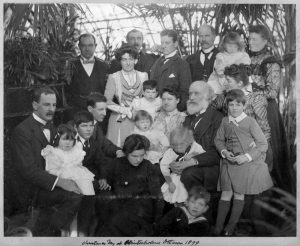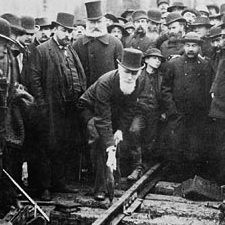1827-1915
Fleming was a true polymath although he finished his formal schooling at the age of 14. He was in turn a surveyor, a lithographer, a map-maker and an engineer. He was also a tireless promoter and became one of the best-known Canadians of his time, belonging to over 70 international societies, writing a dozen books and serving for 35 years as chancellor of Queen’s University. At 24, he designed Canada’s first postage stamp, the “three-penny beaver”. In 1850, he co-founded the Canadian Institute (a scientific society now known as the Royal Canadian Institute for the Advancement of Science), a professional society of architects, surveyors and engineers. He is best remembered today for having championed and facilitated the creation of the standard time system that divides the world into 24 time zones. Towards the end of his life, Fleming also successfully promoted the construction of a trans-Pacific telegraph cable.


Between 1869 and 1882, Fleming lived at Winterholme, a large stone house with several dependencies, the front entrance of which originally opened onto 213 Chapel St. (members of his family occupied the house until 1925). Formerly known as Chapel Court, the house had been built in 1865 for George Édouard Desbarats[1], the Queen’s Printer. Desbarats sold it to Fleming and relocated to Montreal after his Sparks St. printing office was allegedly torched by Fenian sympathizers who objected to a memorial plaque honouring D’Arcy McGee who had been assassinated in front of the building in 1868 (and had lived upstairs). Winterholme underwent major alterations before the First World War: a bay window removed for a new entrance on Daly is said to have been incorporated into Mackenzie King’s ruins at Kingsmere. Used as a convalescent home for servicemen during World War 1, Winterholme was divided into apartments in 1925.
Fleming moved to Ottawa from Halifax in 1869, a year before his friend and family doctor Charles Tupper arrived (Tupper lived just down the street). Fleming had become a wealthy man by then as a result of his business dealings in Nova Scotia and he celebrated his arrival by giving a housewarming ball for 150 guests in his new home. In 1871, the year British Columbia joined Confederation with a promise that Canada would build a railway, he was appointed chief engineer for the Pacific railway while retaining his responsibilities for the completion of the Inter-Colonial Railway to Halifax.
A deeply religious man, Fleming never missed Sunday worship. For the comfort of the railway survey crews who worked for long periods in the field, he developed an inter-denominational prayer service and had it printed as a pamphlet. These prayers became the inspiration of some of Canada’s earliest ecumenical services.
Fleming was a family man who loved children (he had seven of his own) and hosted many parties for them and others, including Mary Macdonald, Sir John A.’s disabled daughter. Instead of trying to remember the birthdays of his many grandchildren, he sent them presents on his birthday instead. In 1905, on his 78th birthday, Fleming played simultaneous chess games with three of his sons and had the satisfaction of winning each one.
[1] It was Desbarats’s wife that Sir Charles Tupper stopped to visit on his way to the office.
